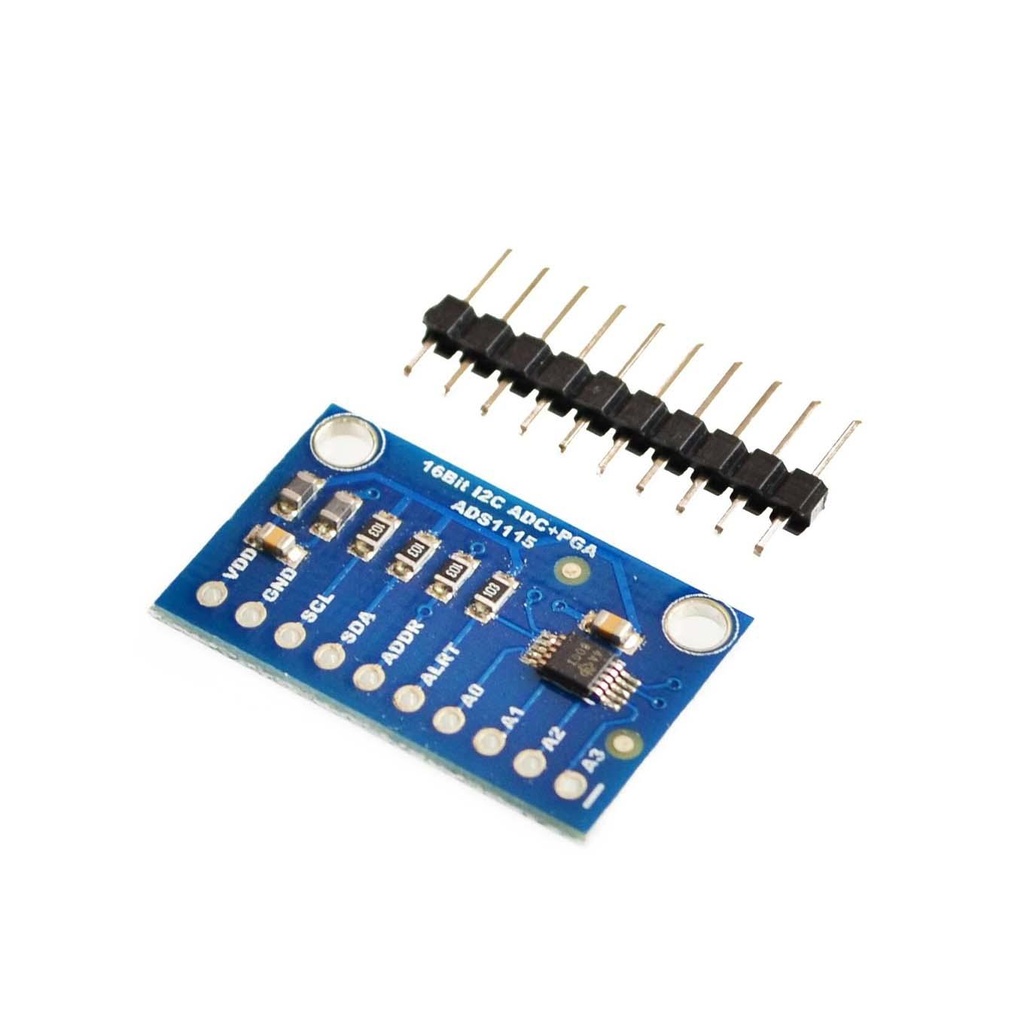ADC 16Bit ADS1115 I2C Analog To Digital Converter Module
The ADS1115 is a 16-bit ADC using the I2C protocol to convert analog voltages into digital values. It features four input channels, a programmable gain amplifier, and low power consumption. Suitable for applications requiring multiple ADC inputs, it supports both single-shot and continuous conversion modes. It operates with a flexible input voltage range (0V to 3.3V or 0V to 5V) and is ideal for sensor interfacing, data acquisition, and battery-powered devices.
The ADS1115 is a 16-bit analog-to-digital converter (ADC) that uses I2C communication protocol. It can be used to convert an analog voltage into a digital value that can be read and processed by a microcontroller. The module provides four input channels for connecting analog sensors and has a programmable gain amplifier to adjust the input range. The I2C interface allows multiple devices to be connected to the same bus, making it a suitable solution for systems that require multiple ADC inputs. The module operates at low power consumption and supports both single-shot and continuous conversion modes.
Package Includes:
- 1 x ADS1115 16-Bit Analog-To-Digital Converter
Features:
- 16-bit resolution for high precision in analog-to-digital conversion
- Four input channels for connecting analog sensors
- Programmable gain amplifier for adjusting input voltage range
- I2C communication protocol for multiple device connectivity on the same bus
- Supports both single-shot and continuous conversion modes
- Low power consumption, suitable for battery-powered applications
- Flexible input voltage range (0V to 3.3V or 0V to 5V)
- Versatile and reliable solution for a variety of applications
Description:
The ADS1115 is a high-precision, 16-bit analog-to-digital converter (ADC) that operates using the I2C communication protocol. It converts analog signals from sensors into digital values that can be read and processed by a microcontroller. The module has four input channels for connecting various analog sensors and features a programmable gain amplifier that enables the input voltage range to be adjusted. This ADC supports both single-shot and continuous conversion modes, allowing it to be used in a wide range of applications. The I2C interface enables multiple devices to be connected to the same bus, making it a great choice for systems that require multiple ADC inputs. Additionally, the ADS1115 operates with low power consumption, making it suitable for battery-powered applications. With its 16-bit resolution and programmable gain amplifier, the ADS1115 provides a high level of precision in the conversion of analog signals to digital values. Its flexible input voltage range, I2C interface, and low power consumption make it a versatile and reliable solution for a variety of applications.
Principle of Work:
The ADC 16Bit ADS1115 I2C Analog to Digital Converter (ADC) operates on the principle of converting an analog voltage signal into a digital representation that can be processed and analyzed by a microcontroller or digital system. The ADC uses a successive approximation register (SAR) architecture to perform the conversion process. The following steps describe the working principle of the ADC 16Bit ADS1115 I2C ADC:
- Sampling: The analog input voltage is sampled at a set interval, determined by the data rate setting of the ADC.
- Comparator: The ADC has an internal comparator that compares the sampled voltage to a reference voltage. The reference voltage is supplied by an internal or external voltage reference.
- Conversion: The ADC starts the conversion process by performing a binary search to determine the digital code that corresponds to the analog input voltage.
- Digital Output: The ADC outputs the digital code representing the analog input voltage as a series of bits.
- Communication: The ADC communicates the digital code to a microcontroller or digital system through the I2C interface.
Pinout of the Module:

- VDD: Power supply pin, typically connected to 2V0 - 5V5.
- GND: Ground pin, connected to a common ground.
- SCL: Clock pin for I2C communication.
- SDA: Data pin for I2C communication.
- ALERT/RDY: Indicates conversion is complete and data is ready to be read.
- ADDR: Sets the I2C address of the ADC (0x48, 0x49, 0x4A, 0x4B).
- Ain0, Ain1, Ain2, Ain3: Multiplexed input pins for analog voltage signals.
Applications:
- Data acquisition
- Sensors and transducers (e.g., temperature, pressure sensors)
- Industrial control systems
- Portable and battery-powered devices
- Robotics and automation
Circuit:
To connect the ADS1115 to an Arduino:
- SDA (ADS1115) to A4 (Arduino)
- SCL (ADS1115) to A5 (Arduino)
- VDD (ADS1115) to 5V (Arduino)
- GND (ADS1115) to GND (Arduino)
- A0 (ADS1115) to the first analog input
- A1 (ADS1115) to the second analog input

Library:
- Open the Arduino IDE.
- Go to Sketch > Include Library > Manage Libraries.
- Search for "ADS1115" and install the "Adafruit ADS1X15" library.
- Include the library in your sketch via Sketch > Include Library > Adafruit ADS1X15.
Code:
#include "Wire.h"
#include "Adafruit_ADS1015.h"
Adafruit_ADS1115 ads;
void setup() {
Serial.begin(9600);
Wire.begin();
ads.begin();
ads.setMode(ADS1115_MODE_SINGLESHOT);
ads.setRate(ADS1115_RATE_250);
ads.setGain(ADS1115_PGA_6_144V);
}
void loop() {
int16_t adc0, adc1, adc2, adc3;
ads.startComparator_SingleEnded(0, 100); delay(1);
while(ads.getConversionPending());
adc0 = ads.getMilliVolts(0);
ads.startComparator_SingleEnded(1, 100); delay(1);
while(ads.getConversionPending());
adc1 = ads.getMilliVolts(1);
ads.startComparator_SingleEnded(2, 100); delay(1);
while(ads.getConversionPending());
adc2 = ads.getMilliVolts(2);
ads.startComparator_SingleEnded(3, 100); delay(1);
while(ads.getConversionPending());
adc3 = ads.getMilliVolts(3);
Serial.print("A0: "); Serial.print(adc0);
Serial.print(" A1: "); Serial.print(adc1);
Serial.print(" A2: "); Serial.print(adc2);
Serial.print(" A3: "); Serial.println(adc3);
delay(100);
}
Technical Details:
- Voltage Supply (VDD): 2V0 ~ 5V5
- Resolution: 16 bits
- Data Rate: 8 ~ 860 SPS
- Operating temperature: -40°C ~ 125°C
Comparisons:
- Resolution: ADS1115 (16-bit) vs ADS1015 (12-bit)
- Input Channels: ADS1115 (4) vs ADS1015 (3)
- Gain Range: More flexible on ADS1115
